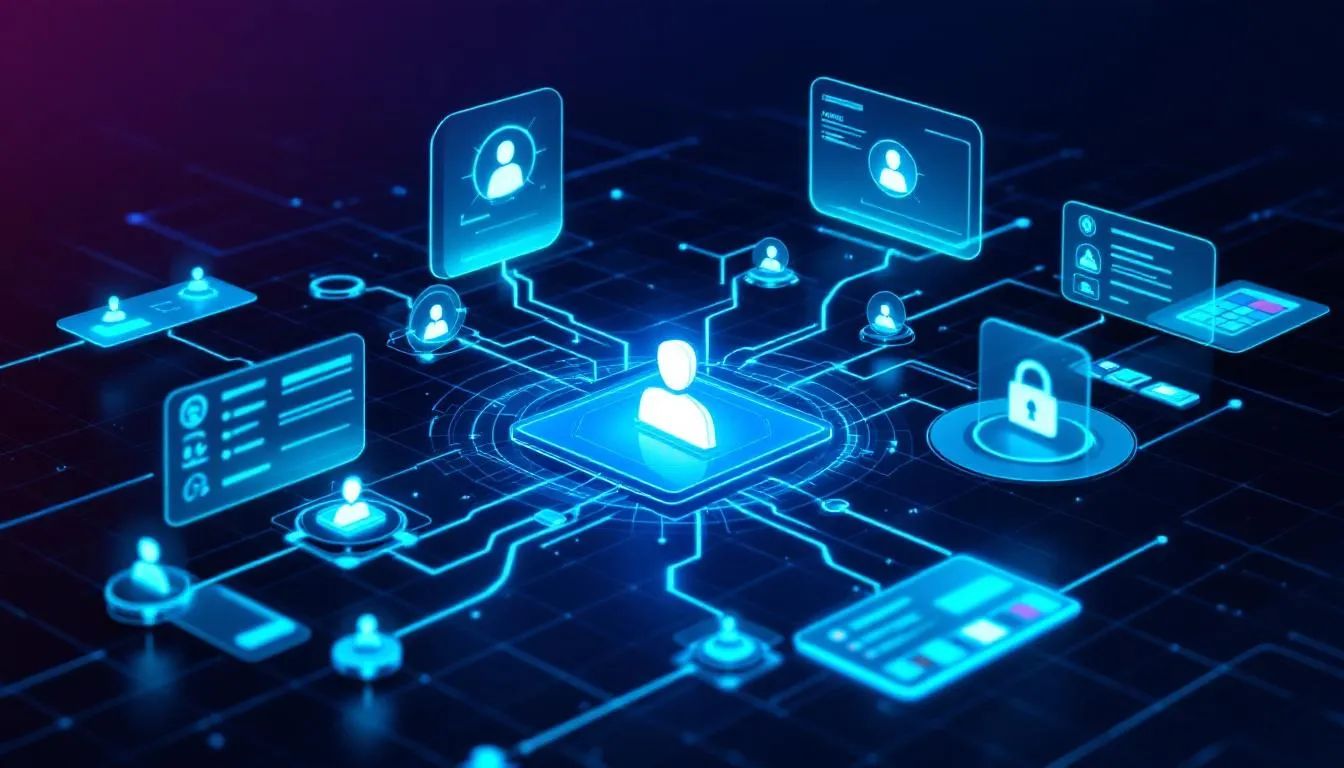Introduction to Identity Management
Identity management is the process of creating, managing, and regulating user identities and their access to technology resources within an organization. This involves the entire lifecycle of user identities — from onboarding and provisioning to modification and eventual deactivation. Identity management systems are designed to securely store and manage user identity data, authenticate users, and authorize access to sensitive data and systems.
By implementing robust identity management practices, organizations can protect their technology resources, prevent data breaches, and ensure that only authorized users have access to critical information. Effective identity management is essential for maintaining security, supporting compliance requirements, and safeguarding the integrity of an organization’s digital assets.
Identity System
A modern identity system is the backbone of digital trust — a framework that verifies users, protects sensitive information, and controls who can access an organization’s resources. Whether for employees, customers, or applications — each an example of an entity managed by identity systems — identity systems ensure that only the right people can perform actions across digital environments.
A core function of identity systems is the protection of user data and organizational assets, achieved through robust security controls and compliance with data security regulations.
Identity systems support every authentication event, authorization decision, and account lifecycle process across the enterprise.
Components of Identity Management
The core components of identity management include identification, authentication, authorization, user management, and directory services. Identification is the process of recognizing and registering a user within the system, while authentication verifies that the user’s identity is genuine, typically based on credentials provided. Authorization determines the level of access and specific actions a user can perform within various systems and services.
User management encompasses the creation, modification, and deletion of user accounts, as well as the assignment and management of user roles and access rights. Directory services act as a centralized repository for storing and managing user identities and their attributes, ensuring consistency across multiple systems. Other components, such as identity federation, enable users to access multiple systems with a single identity, while decentralized identity management empowers users to control their own digital identities using decentralized identifiers. Together, these components form a comprehensive framework for managing access and protecting organizational resources.
Identity Management System
An identity management system securely stores and manages user identity data, including attributes such as usernames, passwords, roles, group membership, and device information. These systems automate onboarding, enforce security policies, and maintain the accuracy of identity records across various applications and systems. Additionally, an Identity Management System is a security framework that provides authorized access to technology resources by authenticating users using a token-based approach.
The Authentication Service in an Identity Management System is responsible for authenticating users and providing self-service options for password resets and sign-ups. User identity data is accessed during authentication and authorization processes to ensure proper user verification and access control.
They are an essential component of every security framework.
Access Management
Access management determines what an authenticated user can do. It relies on policies and roles to grant or restrict access to systems, data, and services. Access management solutions are designed to manage access to sensitive data and systems, ensuring that only authorized users can interact with protected resources. Strong access management ensures that user permissions match job responsibilities and prevents unauthorized exposure of sensitive data. Role-Based Access Control (RBAC) is a key component, assigning permissions based on a user’s specific role within an organization.
Identity and Access Management
Identity and Access Management (IAM) merges identity verification with access control. Identity access management is a comprehensive framework for managing user identities and access to organizational resources, encompassing processes, policies, and technologies. IAM ensures a consistent process for authentication, authorization, privilege enforcement, and compliance. Effective IAM is essential for securing access in hybrid and multi-cloud environments and supports remote work models.

It’s the foundation of modern Zero Trust, requiring users and devices to prove their identity anytime they access resources.
Identity Management Systems
Enterprise identity management systems maintain all digital identities throughout their lifecycle — creation, updates, role changes, and deprovisioning. These systems must handle multiple identities for each entity, as users, partners, customers, and machines can each have various identities with different attributes. These identities are managed throughout their lifecycle to ensure security and compliance.
Their primary goal is to maintain accurate identity information across all connected systems.
Identity Management
Identity management focuses on the processes, policies, and technologies used to define, maintain, and validate user identities. It ensures organizations can authenticate individuals, authorize actions, and control access to applications and data. A key aspect is the ability of identity management systems to support interoperability with standards like SCIM and facilitate data exchange for user identity management across different systems.
Effective identity management reduces risk and improves operational efficiency. These systems manage a wide range of user attributes, permissions, and ancillary data — such information is essential for authorization and compliance. Effective identity systems are part of a comprehensive Identity and Access Management (IAM) framework.
Decentralized Identity Management
Decentralized identity management shifts identity control from centralized providers to individual users. Instead of storing credentials in a single database, users maintain digital identities in secure identity wallets using cryptographic keys. Decentralized identity management leverages a distributed network to verify and manage digital identities, ensuring secure authentication across connected systems. This approach enhances security by storing user identities on their devices, reducing the risk of a single point of failure.
This model enhances privacy, minimizes reliance on third parties, and reduces the chances of mass data breaches.
Federated Identity Management
Federated identity management allows a user’s identity to be used across multiple systems using standards like SAML, OAuth, or OpenID Connect. This reduces friction by enabling users to authenticate once and gain access to multiple connected applications. In federated identity management, the service provider acts as the relying party, accepting assertions from the identity provider to verify user identity. The federation service and token service are closely related components that work together to enable cross-domain authentication. Single Sign-On (SSO) allows users to access multiple applications with a single set of credentials.
It’s the basis of “login with Google,” “login with Microsoft,” and enterprise SSO solutions.
User Access
Controlling user access is vital for both security and usability. Access decisions are based on the verification of the user's identity, ensuring that only authorized individuals can access specific resources. Identity systems ensure users have the correct access rights at the correct time, preventing privilege sprawl and unauthorized actions. User access must be monitored, verified, and adjusted as roles evolve. User management involves the creation, modification, and deletion of user accounts and managing user roles and access rights. Auditing and reporting involve tracking access logs and user activity to detect suspicious behavior and ensure compliance.
Visual Identity
Beyond technical access, a user’s visual identity — such as their avatar, profile badge, or UI display name — helps build trust and reduce confusion across platforms. While often overlooked, visual identity plays a key role in clarity and user experience. It is important to focus on core, reusable design elements such as logos, color schemes, and typography to ensure consistency and efficiency in the design process.
Visual identity systems ensure universally consistent graphics for a brand’s digital and physical presence. Design teams create and maintain these systems to establish a cohesive brand image. A visual identity system should be thoughtfully created to serve as a foundation for consistent branding and future scalability. A visual identity system is a set of defined rules for creating consistent designs, product messaging, and branded sales materials. A good visual identity system will be equipped with clear usage guidelines to avoid branding inconsistencies. Design teams must take ownership of the visual identity system for it to be effective. A visual identity system should be future-friendly and scalable for future projects.
Color sets the emotional tone of a brand before a single word is read, making it a crucial part of a visual identity system. Typography is your brand’s voice in visual form, and the font choices made say as much about the brand as the words themselves. The core elements of a visual identity system include logos (with common types such as wordmarks, lettermarks, and symbols), color schemes, typography, and design styles.
Atlassian’s visual identity system is a perfect example for design teams, providing comprehensive guidelines and assets. For example, a company might apply its visual identity system by ensuring all marketing materials, websites, and product interfaces use the same logo, color palette, and typography, resulting in a unified and recognizable brand presence. A visual identity system saves brands a significant amount of time and resources while projecting a distinct and unified identity.
Identity Federation
Identity federation connects multiple identity providers so users can authenticate using a single identity across various systems. This reduces password fatigue, improves consistency, and ensures organizations maintain control without storing unnecessary credentials.
Federation protocols are implemented to enable secure authentication across domains, ensuring seamless and protected access for users.
Manage Identities
Organizations must manage identities efficiently to maintain security and compliance. To achieve this, organizations must implement automated tools and workflows that streamline identity management processes. This includes provisioning accounts, managing identity attributes, resetting credentials, and removing access during offboarding. Identity management tools automate these tasks to reduce errors and improve governance.
Data Breaches
Poor identity controls frequently lead to data breaches. Stolen credentials, misconfigured access rights, and weak authentication protocols allow attackers to impersonate legitimate users. Strong IAM practices protect user data and reduce the risk of unauthorized access. Multifactor authentication (MFA) adds an additional verification step to enhance security during the login process.
IAM Systems
IAM systems bring together identity management, access management, authentication, authorization, and identity governance. These systems integrate with HR software, directories, cloud platforms, and internal applications to automate identity lifecycle tasks. Automation in IAM systems reduces the administrative burden on IT staff by managing user provisioning and password resets. Self-service portals and SSO improve user experience, productivity, and satisfaction. IAM systems must be constantly updated as people join or leave the organization, and as their roles change.
OpenID Connect
OpenID Connect (OIDC) is one of the most widely used authentication protocols. It allows identity providers to verify users and deliver identity attributes to relying parties. OIDC simplifies SSO, improves user experience, and strengthens authentication across web and mobile applications.

Some real-world examples of OpenID Connect usage include enabling single sign-on for enterprise applications, integrating social login with providers like Google or Microsoft, and securing access to APIs in cloud services.
Benefits and Challenges
Implementing an identity management system offers significant benefits, including enhanced security, improved operational efficiency, and stronger compliance with regulatory standards. By centralizing the management of user identities and access, organizations can reduce the risk of unauthorized access to sensitive data and minimize the likelihood of data breaches.
Identity management systems streamline the process of managing user identities, reducing administrative overhead and ensuring that access rights are always up to date. However, deploying and maintaining an effective identity management system can be complex, requiring dedicated resources, specialized expertise, and ongoing attention to system configuration and policy enforcement. Organizations must carefully balance the need for robust security with the practical challenges of managing identities across diverse systems and user populations.
Best Practices and Solutions
To maximize the effectiveness of identity management, organizations should adopt best practices such as implementing multi-factor authentication, using secure authentication and authorization protocols, and conducting regular reviews of user access rights. Choosing an identity management system that is scalable, flexible, and user-friendly is crucial for supporting organizational growth and adapting to changing security needs. Real-time monitoring and reporting capabilities help organizations detect and respond to potential threats quickly.
Solutions like identity and access management (IAM) systems, decentralized identity management, and federated identity management provide comprehensive tools for managing user identities and access across multiple systems. Prioritizing user experience, offering training, and providing ongoing support are also essential for ensuring that users can effectively interact with the identity management system and maintain security best practices.
Implementation and Governance
Successful implementation of an identity management system begins with a clear understanding of organizational requirements and objectives. Organizations should carefully evaluate and select an identity management system that aligns with their security needs, scalability goals, and user experience expectations. Proper design and configuration are critical to ensure the system is secure, efficient, and easy to use. Establishing strong governance is equally important — this includes developing policies and procedures for managing user identities, defining access controls, and ensuring compliance with relevant regulations and standards.
Ongoing monitoring, regular reviews, and timely updates to the identity management system are necessary to maintain its effectiveness and adapt to evolving security threats and organizational changes. By prioritizing both implementation and governance, organizations can ensure that their identity management system remains a vital component of their overall security strategy.
Frequently Asked Questions
What is an identity system?
A framework that manages digital identities, authenticates users, and controls access to organizational resources. Centralized identity management simplifies the process of managing user access across various systems and applications by storing all user identities in a single location.
For instance, in a large corporation, an identity system may be used to automatically revoke access to sensitive resources when an employee leaves the organization.
Why is identity management important?
It ensures security, compliance, and efficient access management while reducing risks related to stolen credentials and privilege misuse.
What is decentralized identity?
A model where users control their own digital identity using cryptographic keys, reducing reliance on centralized databases.
How does federated identity work?
It enables users to authenticate once with a trusted identity provider and gain access to multiple systems or services.
What does an IAM system include?
Authentication, authorization, access governance, lifecycle management, and audit capabilities.
What is OpenID Connect used for?
To securely verify users through an identity provider and relay identity information to connected applications.
